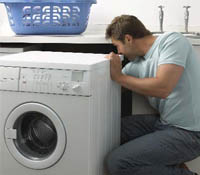Washing Machine Drainage Plumbing
If you are working on a laundry room in a new home or are in the process of repairing your own laundry room, you will need to install the drainage plumbing connections for the room's washing machine to work properly. Even if you don't have extensive plumbing experience, as long as you're comfortable working on home projects, you should have no trouble successfully completing this one.
What Materials and Tools Does This Plumbing Project Require?
Since you're a DIY type of person, you will already have all of the basic carpentry tools needed for this project. Depending on the types of projects you normally do, you may also have the necessary soldering and PEX tools. The main materials you'll need to get for this project are pipe, glue and primer. You'll also want to have a washer box and drainage fittings. Prior to starting, you will want to find out if your local ordinances require you to obtain a plumbing permit for this project.
Washing Machine Drainage Plumbing Specs
Keep in mind that there are some basic specs you will need to follow to ensure your plumbing installation is successful. The washing machine standpipe and trap need to be two inches. When you're planning out where you're going to place the standpipe, make sure you put it at least twenty-four inches above the trap weir. Your plans should also place it so that the standpipe terminates above the washing machine rim's flood level.
How to Install Washing Machine Drainage Plumbing
Prior to getting started, the one other item you will need to check is the type of trap you're using. You will want to confirm that it either has a cleanout plug that's integrated or is removable. This will ensure you don't have future drainage problems that result from sand or lint clogs. After checking this component, you can begin the plumbing installation. Since you want the finished job to look nice, you will want to hide the washer box and all of the plumbing by installing it inside of the wall.
As you will see, your washer box will feature a:
- Connection for a hot faucet
- Cold faucet connection
- Stand pipe hole that allows water to drain
When you install the washer box in the wall, you will want to put it 3 1/2 feet above the floor. As you measure this height, make sure that it comes above the flood level rim of the washing machine. Once your washer box is in place, you can find the home's gravity drainage system. After locating this system, you will be able to successfully vent the drainage trap. The reason it's important to vent the trap is to avoid an air blockage.
The last washing machine drainage plumbing item you need to address is the water supply. The hot and cold supply should be a half inch. You should also choose a location for this plumbing installation that makes it easy to reach in case it needs to be turned off. Once you finish installing the water supply, the drainage plumbing will be fully functional.

